This is the story of what would have been a piece of firewood's journey.
That journey began before I found this piece of firewood in this pile on my neighbor's porch. A few weeks earlier it had been part of a standing tree. In a week or less it would have become, after providiing a little warmth to a frail elderly neghbor -ashes in an ash can.
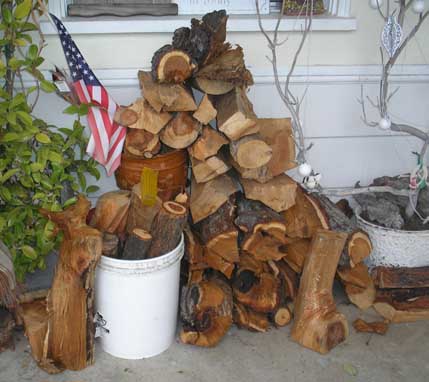
Being a wood turner, I saw that it was probably a fruitwood, probably with plenty of nice heartwood patterns hidden inside. So I asked my neighbor if I could have it - and I thus became part of its journey.
Having only a small JET Mini lathe, bandsawing off some wood was needed. The burned pitch ladened bandsaw blade removed what needed removing - and left burned surfaces on what was now The Blank. So The Blank had the marks of the chainsaw that had cut it down to size, a jagged Split Wood face, the natural surface logs have, just below the bark - and surfaces cut and scortched by a bandsaw blade - the post card evidence of its journey - so far.
With The Blank mounted between centers, the split face to be the top of the piece, I turned a tenon on the bottom for later gripping in a chuck and began turning the profile of what I thought would be a small heartwood bowl. Getting it to round involved a lot of THUNK-THUNK-THUNK cutting - the piece being WAY out of balance - and low RPMs needed in order to keep the lathe from walking all around the shop.
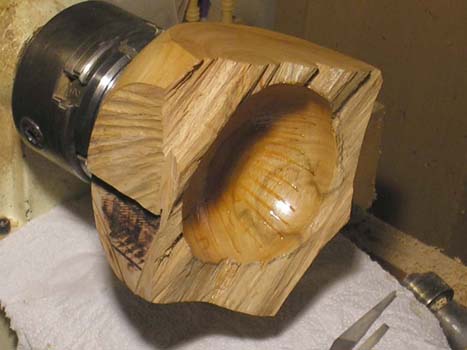
When I'd turned up to the hight point on The Blank, it became apparent that an "all heartwood normal bowl "would be pretty small. It would be a nice, pretty little thin walled bowl - just small. BUT - looking at all the textures on The Blank, evidence of its journey to this point, I decided to leave them alone - except for turning a concave hemisphere into the top, sanding it smooth and giving it a coat or two of dewaxed garnet shellac ( I LOVE to French Polish - it's meditative ). And just to emphasize the turning part of the journey, I pooled some thicker cut shellac in the bowl, quickly remounted the piece - and spun it. The result was a potential paradox - something dripping - UP?!
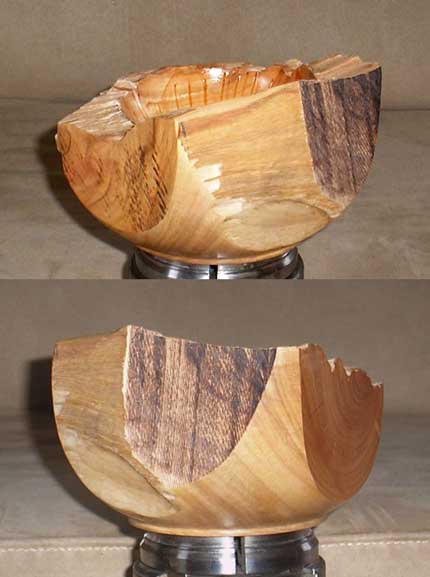
The Dripping Up thing, thinking about it, seemed just a bit too gimmicky - and - rather than adding anything to the piece, was a distraction. I wasn't at all thrilled with the idea of having to turn the drips away. Because the piece is so out of balance, and because the top is so slanted, turning into the top would involve lower RPMs to keep way out of balance piece from shaking - a lot. And cuts made mainly in air - into split side grain - is likely to split out wood
I sharpened a round nose scraper as sharp as I could get it, dialed up the RPMs 'til the shaking got scary, then dialed it down to a less scary speed. Got the tool rest in as close as I dared and set above center so I could angle the scraper down - to cut with its bur. Tried for one continuos scrape from high point to the bottom of the hemispherical concavity and got only half way down, unable to swing the scraper any farther down the side. Back to the grinder to put new bur on the scraper and then, starting at the bottom, dead center made a scraping cut up the side of the bowl, the cut getting lighter and lighter as I approached the end of the previous pass.
Almost pulled it off - but not quite. Some hairy sanding was going to be needed - and with this piece - I was not looking foreward to that - at all. Cutting in air is tricky. Hand sanding mainly air is even trickier. Having wood wack your fingers four or five hundred times a minute is - not pleasant. Wapped some paper towels around a 3/4" dowel, folding it over the end and rubber banded it to the dowel. Repeated that with 120 grit Abranet and started sanding - air - air - air - air - WOOD!
Unexpectedly, that air - air - air - air - WOOD thing resulted in sanding away some of the jagged side grain of the top, removing a sharp crips jagged edge from the high area of the "rim", while leaving a sharp crips jagged edge lower down. As I worked through the grits, I exploited that surprise smoothing thing. When I arrived at a fairly smooth surface I shut off the lathe and went at the piece with micro mesh - 1500 to 1200 - rubbing out finer and finer scratches. When I got things as smooth as I could I started "french polishing" on thinned clear DEFT lacquer. I really enjoy french polishing. It's almost a meditative thing, small over lapping circles, now clockwise, now counter clockwise, all the while pressing firmly - to work the finish into the surface of the wood. And as the finish builds, a depth is added to the surface - slowly - hand cramping slowly. But the almost direct contact with the wood provides some interesting feedback from the wood - visually and tactily.
Finally, I could remove the piece from the chuck it had been in for days and hold it for the first time. It's not a big piece - being only about 7" acrossed the top at it's widest and about 3 1/2" to its highest point - but it has a nice heft to it. This was quite different from my other turnings, which are turned to be as thin walled andlight as I can possibly turn.
But what was surprising was the feel of the thing - all these different surfaces and all these different feels.
In this view you see sanded smooth end grain, a sanded less smooth surface off a cutting tool on the lathe, a chain sawn surface left untouched and a flat sanded surface - with a few band sawn texture left to see and feel. On the top you have the split wood surfaces meeting the different textured side surfaces - with smooth surfaces flowing into the bowl in some places and abrupt edges of the inside of the bowl. Everywhere you put your hand, you feel two or three different surfaces, each with a significantly different feel.
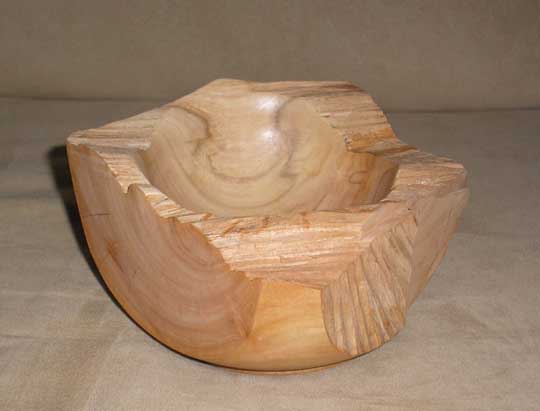
Turn the piece clockwise and you see, and feel a turned surface, a chainsawn surface, a small drop off, onto a bandsawn surface that's had some sanding done to it.
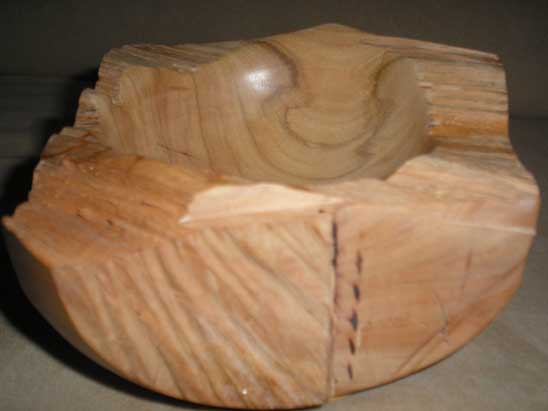
Turn it clockwise some more and you've got another bandsawn surface, a turned surface and your back to the end grain surface again.
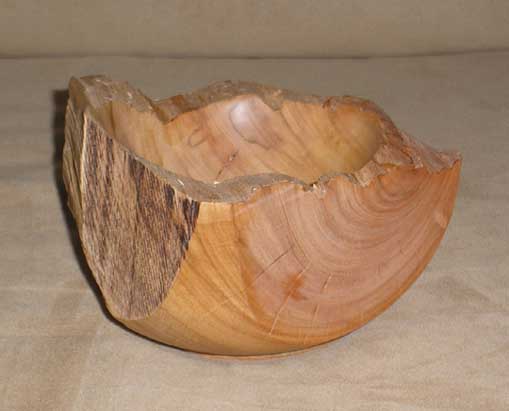
Go from sides to top and you're in jagged split wood surfaces, in some areas blending into smooth surfaces that flow down into the bowl, in other areas a sharp jagged rim dropping suddenly into the smoothed insides of the bowl.
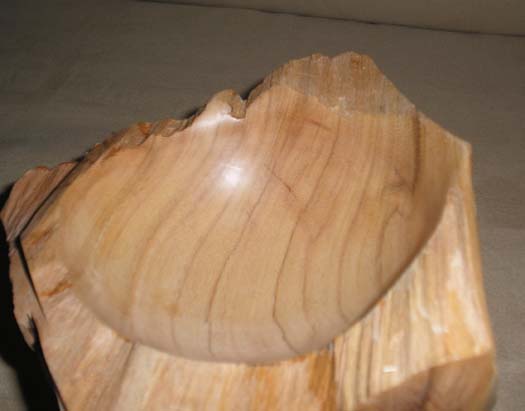
Visually, its an interesting piece - in part because it shows most of its journey from firewwood pile to the present. It's when you close your eyes and let your fingertips do the exploring that it gets quite interesting - a very tactile piece.
Now it'sodd that our contact with the wood is usually Once Removed. We feel how our tools are interacting with the wood as we make cuts. And though we often use sanding devices where we are Twice Removed from the wood - a layer of sand paper and a tool that holds it between us and the wood, we usually use compressed air to blow sanding dust off the piece - not touching it at all. And when we apply finishes, it's usually on a rag or with a buffing wheel - so we're back to being Once Removed from the wood.
But this piece begs to be handled and explored with finger tips - eyes shut so as not to be distracted - by illusory reflected light.
As this thing evolved I've been taking it back to show the old man who let me have it from his wood pile. Until today it'd still been in a scroll chuck, awkward to handle because of the combined weight. Until today he was - well let's just say he was less than impressed. He'd liked the idea of leaving some of the textures that were on it when I rescued it - sort of like the wrinkles anbd scars one acquires in the process of living life.
He was in his recliner, covered with a blanket, a fire going in the fireplace. Cold wet winter days are not kind to the frailer elderly, warmth takes a fire in the fireplace nearby - and a blanket or two. This time, he held only the piece of fire wood I'd been showing him for days - finally off the chuck.
"It's still pretty heavy." was his only comment.
"Close your eyes and run your fingers over the different surfaces." I suggested.
He closed his eyes and his fingertips started wandering over the surfaces on the pieces.
"Pretty smooth here, but this side - chainsaw marks. They feel different than they look - kind of nice."
His fingertips kept exploring.
"This is some of the outside of the log that you left".
Now this old guy, until about a year ago, had been splitting firewood for his fireplace for decades. He was familiar with how different parts of a log feel. He knew the look and feel of split wood, chainsaw marks and the surface a handsaw leaves in wood and his fingertips recognized them when encountered.
As his fingertips went over the top's split wood surface and encountered the smoother and smoother surfaces of the inside of the bowlls turned surface a smile started on his face that got bigger as his fingers ran around near the smooth and polished bottom of the inside of the bowl.
"This is really really smooth - really different from the rest of this thing. Feels kind of nice." - and his smile got a bit bigger.
His short term memory isn't what it used to be and he suspected I'd pulled a Switcheroo on him. So I went out on his porch and brought in a sibling of this piece from the wood pile out there.
"It's the same piece from your woodpile that I've been showing you for days."
Still running his fingers over the piece he said "Who'd have thought something like this was in that pile of firewood. Kind of interestijng, especially to feel."
I've played with all sorts of turning and all sorts of ways of enhancing my turnings - laser engraving, pyrography, piercing, carving, scortching, patinas and dyes - and even micro computer controlled "behaviors" - internal lighting, sound, movement, vibration. And I've sculpted pieces to the point where they're barely recognizable as turnings. But THIS type of piece may be what I've been searching for. I am, I think, a sensualist. And this piece really appeals to my sense - of touch - direct - physical contact with a piece of wood that makes me very aware of the medium I play with. Some of its journey from a piece of a standing tree to what it is now is right there to see. But to experience its journey more - you must close your eyes - and FEEL it.
What's YOUR reaction to all this? Is it just artsy fartsy - or does some of this make sense to you?
I'd like to hear your reaction to all this so e-mail me if you care to.